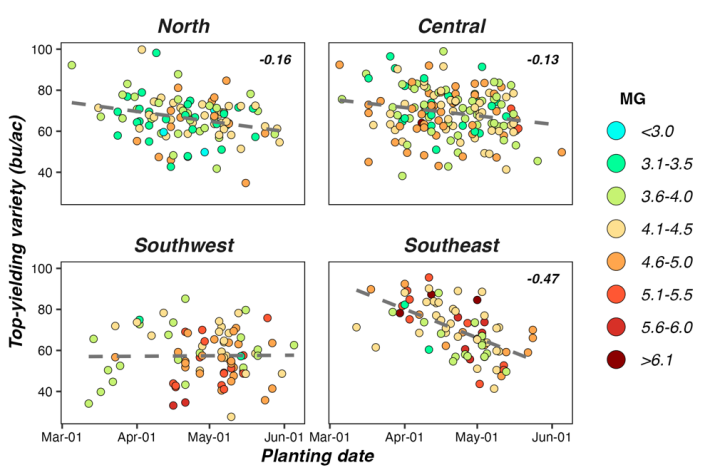COLUMBIA, Mo. – A grower’s planting operation and crop stand establishment is the most critical event in every farmer’s calendar, said Andre Reis, University of Missouri Extension state soybean specialist.
“While late-season weather often influences final soybean yields, the potential yield is primarily set during planting, considering the ideal combination of planting date, variety (and its maturity group), and plant population,” he said. “Any stress the soybean crop encounters throughout the remaining growing season will either diminish or maintain the yield potential established during planting.”
The MU Variety Testing Program (MUVT) and seed companies support growers in variety selection by releasing field trial results.
“When focusing only on the top-yielding varieties in each MUVT and seed company’s trials, there is a clear overall relationship between planting date and actual yield: The later the planting date, the lower the potential yield,” Reis said.
The southeast region of the state shows the strongest yield penalty, with a loss of 0.46 bushels per acre per day from March to June, followed by the north and central regions, with penalties of 0.16 and 0.13 bu/acre/day, respectively. The southwest region did not show the same trend, mainly due to not recording yields as high as the other regions before April. While the decrease in yield over time has been noted in previous studies, there is considerable variability in the data across different regions, he said.
Conversely, there are fewer instances of high yield records from mid-May to June, except in the southwest region.
How to adjust variety selection or maturity group (MG) as the planting season progresses?
“Unfortunately, establishing a clear relationship between the MG of top-yielding varieties and planting date is not always straightforward using a simple model,” Reis said. “There is no strong trend indicating a particular MG associated with higher yield at the beginning or end of the planting season. This does not imply that such a relationship does not exist; rather, it suggests that capturing it is challenging. In response, the MU Soybean Farming System research group will initiate multi-environmental trials in 2024, specifically designed to optimize MG, planting date and plant population across Missouri regions.”
In the meantime, a machine learning model, simulating different planting dates and weather conditions at the county level, can be helpful. In a wet year, early April plantings should predominantly use early maturity groups in most counties, except in the Bootheel region, where intermediate and later MGs are more likely to yield higher returns. As planting progresses into May and June, most of the state should transition to intermediate MGs. “It’s important to note that terms like ‘early,’ ‘intermediate’ and ‘late’ are relative and depend on the region. A 4.0 MG may be considered intermediate in the north but early in the south,” said Reis.
In dry years, the prediction suggests a shift toward more intermediate MGs in the northern region and early MGs in the rest of the state for April plantings. This transitions to intermediate MGs in most of the state by May and late MGs by June plantings, particularly in the Bootheel and certain areas in the northern region. The change in MG from wet to dry years likely reflects a strategy of drought avoidance by adjusting seed filling away from the hot and dry late July and August period.
Many challenges in establishing a soybean crop with high yield potential
Opting for an early planting date, if weather permits, may be a proven strategy to secure high yield potential. The selection of the optimal maturity group according to the region is crucial, Reis said. The optimal maturity group may change with the planting date and later-season weather conditions, adding complexity to variety selection and increasing uncertainty.
Future research from the MU Soybean Farming System Program will address the interplay among planting date, maturity group and plant population. Find more information about the UM Variety Testing Program at https://varietytesting.missouri.edu.
See complete article from MU Integrated Pest Management at https://ipm.missouri.edu/croppest/2024/3/optimizing_soybean_planting-af.
Contact: Andre Reis, 573-882-4771, areis@missouri.edu
Images
https://extension.missouri.edu/sites/default/files/legacy_media/wysiwyg/News/photos/20240405-soybean-1.png
Figure 1. Field trial sites (n=422) evaluating soybean variety performance in Missouri. The dataset includes data from the MU Variety Testing Program spanning 2010 to 2023 (n=206) along with publicly available data from Asgrow, Becks, Channel, FS, Golden Harvest, NK, Nutech and Pioneer covering 2020 to 2023 (n=216). The yield of the best soybean variety in each Missouri region is displayed according to the planting date of the field trial. Colors indicate the maturity group of the best variety. The number at the top right is the negative trend in bu/ac/day.
https://extension.missouri.edu/sites/default/files/legacy_media/wysiwyg/News/photos/20240405-soybean-2.png
Figure 2. Simulation results for the recommended best maturity groups (early, intermediate and late varieties) at the Missouri county level across six scenarios. These scenarios include three planting dates (April 10, May 20 and June 30) under two weather conditions (wet and dry years). Early, intermediate and late MG are relative for each state region.

